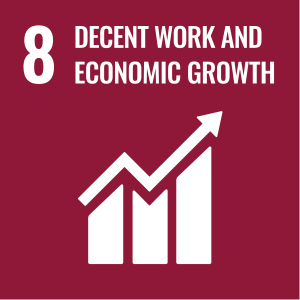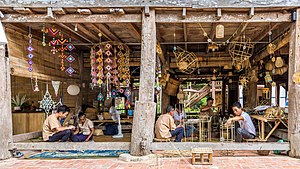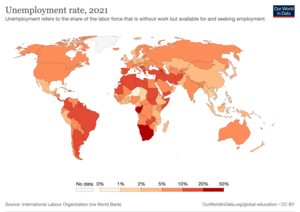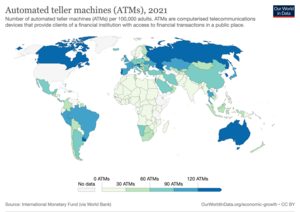Sustainable Development Goal 8
| Sustainable Development Goal 8 | |
|---|---|
 | |
| Mission statement | "Promote sustained, inclusive and sustainable economic growth, full and productive employment and decent work for all" |
| Commercial? | No |
| Type of project | Non-Profit |
| Location | Global |
| Founder | United Nations |
| Established | 2015 |
| Website | sdgs |
Sustainable Development Goal 8(SDG 8orGlobal Goal 8) is about "decent work and economic growth" and is one of the 17Sustainable Development Goalswhich were established by theUnited Nations General Assemblyin 2015. The full title is to "Foster sustained, inclusive andsustainable economic growth,full and productiveemploymentand decent work for all. "[1][2]Progress towards targets will be measured, monitored and evaluated by 17 indicators.
SDG 8 has twelve targets in total to be achieved by 2030. Some targets are for 2030; others are for 2020. The first ten areoutcome targets.These are; "sustainableeconomic growth;diversify,innovate and upgrade foreconomic productivity","promote policies to support job creation and growing enterprises "," improveresource efficiencyin consumption and production ", 'fullemploymentanddecent workwithequal pay', 'promote youth employment, education and training', 'endmodern slavery,trafficking,andchild labour', 'protectlabour rightsand promote safe working environments', 'promote beneficial andsustainable tourism', universal access to banking, insurance andfinancial services.In addition, there are also two targets formeans of implementation[3],which are: Increaseaid for tradesupport; develop a global youth employment strategy.
For theleast developed countries,the economic target is to attain at least a 7 percent annual growth inGross Domestic Product(GDP). In 2018, the global growth rate of realGDP per capitawas 2 per cent.[4]
Over the past five years, economic growth in least developed countries has been increasing at an average rate of 4.3 per cent.[5]In 2019, 22 per cent of the world's young people were not in employment, education or training.[5]
Background[edit]

For close to three decades, the number of workers living inextreme povertyhas reduced drastically. This is despite the lasting impact of the2008 economic crisisandglobal recession.Indeveloping countries,34 per cent of total employments were for the middle class, a number that has increased rapidly between 1991 and 2015.[6]
Employment growth since 2008 has "averaged only 0.1% annually, compared with 0.9% between 2000 and 2007".[7][8]
SDG 8 aims at fosteringsustainableand equitableeconomic growthfor all workers, irrespective of their background, race orgender.[9]This means achieving "higher levels ofeconomic productivitythrough product diversification, technological upgrading andinnovation,including through a focus on high-value added andlabour-intensivesectors. "[9]
Targets, indicators and progress[edit]
The UN has defined the 12 Targets and 17 Indicators forSDG8. The 12 Targets specify the goals and Indicators represent the metrics by which the world aims to track whether these targets are achieved by using the years stated and documented for the indicators actualisation. Two of the indicators are to be achieved by the year 2020, one by the year 2025, and the remaining fourteen indicators are to be achieved by 2030.[10]
Target 8.1: Sustainable economic growth[edit]

The full title of Target 8.1 is: "Sustainper capitaeconomic growth in accordance with national circumstances and, in particular, at least 7 per centgross domestic productgrowthper annumin theleast developed countries".[2]
It has one indicator: Indicator 8.1.1 is the "Annual growth rateof realGDPper capita ".[11]
Achieving higher productivity will require diversification and upgraded technology along with innovation, entrepreneurship, and the growth of small- and medium-sized enterprises (SMEs).
In 2018, the global growth rate of realGDP per capitawas 2 per cent.[4]
Target 8.2: Diversify, innovate and upgrade for economic productivity[edit]

The official wording for Target 8.2 is: "Achieve higher levels ofeconomic productivitythrough diversification, technological upgrading and innovation, including through a focus on high-value added and labour-intensive sectors. "[2]
It has one indicator: Indicator 8.2.1 is the "Annual growth rate of realGDPper employed person ".[11]
A large portion ofNorth America(Canadaand theUnited States) had an average 0.5% increase in GDP per employed person, but overall, the continent had an approximate -0.53% decrease in productivity.South Americahad an overall decrease in GDP per employed person, withVenezuelaexperiencing the largest change at -31.8%. The continent overall met an approximate -2.56% decrease in productivity.[11]
Asiahad an overall increase in GDP per employed person. It had an approximate 2.1% increase in GDP per employed person with a large portion (China) seeing a 6.6% increase.Europehad an overall increase in GDP per employed person. It had an approximate 1.3% increase with a large portion (Russia) seeing a 2.5% increase.Africahad an overall increase in GDP per employed person. It had an approximate 0.4% increase.Oceaniahad an overall increase in GDP per employed person. It had an approximate 0.85% increase with a large portion (Australia) seeing a 0.2% increase.[11]
Target 8.3: Promote policies to support job creation and growing enterprises[edit]

The official wording for Target 8.3 is: "Promote development-oriented policies that support productive activities, decent job creation,entrepreneurship,creativity andinnovation."[2]
It has one indicator: Indicator 8.3.1 is the "Proportion ofinformal employmentin non-agriculture employment, by sex ".[11]
Jobs that fall under the Informal employment in non-agricultural employment include; unregistered and/or small-scale private unincorporated enterprises engaged in the production of goods or services meant for sale or barter, self-employed street vendors, taxi drivers and home-base workers, irrespective of size.[11]
Target 8.4: Improve resource efficiency in consumption and production[edit]

The official title of Target 8.4 is: "Improve progressively, through 2030, globalresource efficiencyin consumption and production and endeavour to decouple economic growth fromenvironmental degradation,in accordance with the 10‑Year Framework of Programs onSustainable Consumptionand Production, withdeveloped countriestaking the lead. "[2]
It has two indicators:
- Indicator 8.4.1: Material footprint, material footprint per capita, and material footprint per GDP
- Indicator 8.4.2: Domestic material consumption, domestic material consumptionper capita,and domestic material consumption perGDP
Thetotal material footprintis the sum of the material footprint for biomass, fossil fuels, metal ores and non-metal ores. Data on material footprints are outdated and unavailable after the year 2010.[11]Material footprint per capita has had an increase of 39 per cent from the year 2000 to 2017 reaching 12.18 tonnes and material footprint per unit of GDP has had an increase of 7 percent from the year 2000 to 2017 reaching 1.16 kg.[11]
Domestic material consumption per capita has increased by 11 per cent from 2010 to 2017 reaching 12.17 tonnes and domestic material consumption per unit of GDP has not increased between 2010 and 2017 staying at a value of 1.16 kg.[11]
Target 8.5: Full employment and decent work with equal pay[edit]

The full title for Target 8.5 is: "By 2030, achieve full and productive employment and decent work for all women and men, including for young people andpersons with disabilities,and equal pay for work of equal value ".[2]
Target 8.5 has two indicators:[11]
- Indicator 8.5.1: Average hourly earnings of female and male employees, by occupation, age and persons with disabilities
- Indicator 8.5.2:Unemploymentrate, by sex, age and persons with disabilities
Average earnings are reported for male and female employees, but not available across countries for further breakdowns.[11]In 2017, "a factor-weighted gender pay gap of 19 per cent was determined".[14]
Target 8.6: Promote youth employment, education and training[edit]
The full title for Target 8.6 is: "By 2020, substantially reduce the proportion of youth not in employment, education or training".[2]Unlike most SDG targets set for the year 2030, this is set to be achieved by 2020.[11]
It has one indicator. Indicator 8.6.1 is the "Proportion of youth (aged 15–24 years) not ineducation,employmentor training ".
Most SDGs are either set to be reached by 2020 or 2030. While SDG 8, is due in 2030 target 8.6 has already expired in 2020.
In 2019, "22 per cent of the world's young people were not in employment, education or training, a figure that has hardly changed since 2005".[14]
In Canada, over the years there has been a slight decrease in the number of youths not associated with education, employment and or training (NEET). The NEET rates in 1975 were 18% and in 2020, the NEET rates were 20%.[15]
While there has been progress in many North American and European Countries, this is not the case for most African countries. As the NEET rates for youth in the majority of African countries are higher today than in 2015 (when the SDGs were originally implemented).[16]
Youth that is NEET, are more likely to have adverse effects on their emotional, physical and psychosocial wellbeing.[17]The lack of decent employment can also contribute to exacerbating global issues such as poverty and mass migration.[16]

Target 8.7: End modern slavery, trafficking, and child labour[edit]
The full title for Target 8.7 is "Take immediate and effective measures to eradicate forced labour, end modern slavery and human trafficking and secure the prohibition and elimination of the worst forms of child labour, including recruitment and use of child soldiers, and by 2025 end child labour in all its forms".[2]
There is one indicator: Indicator 8.7.1 is the "Proportion and number of children aged 5–17 years engaged in child labour, by sex and age".[11]
Target 8.8: Protect labour rights and promote safe working environments[edit]
The full title of the Target 8.8 is: "Protect labour rights and promote safe and secure working environments for all workers, including migrant workers, in particular women migrants, and those in precarious employment".[2]
It has two indicators:[11]
- Indicator 8.8.1: Frequency rates of fatal and non-fatal occupational injuries, by sex and migrant status
- Indicator 8.8.2: Level of national compliance with labour rights (freedom of association and collective bargaining) based onInternational Labour Organization(ILO) textual sources and national legislation, by sex and migrant status
Target 8.9: Promote beneficial and sustainable tourism[edit]
The full text for Target 8.9 is "By 2030, devise and implement policies to promote sustainable tourism that creates jobs and promotes localcultureand products. "[2]
It has two indicators:[11]
- Indicator 8.9.1: Tourism directGDPas a proportion of total GDP and in growth rate
- Indicator 8.9.2: The proportion of jobs in sustainable tourism industries out of total tourism jobs
A proposal has been tabled in 2020 to delete Indicator 8.9.2.[18]
Every country will be able to generate income as it aims at improving its tourist attraction.[11]

The United Nations World Tourism Organization (UNWTO) defines sustainable tourism as “tourism that takes full account of its current and future economic, social and environmental impacts, addressing the needs of visitors, the industry, the environment, and host communities”[19]
Target 8.10: Universal access to banking, insurance and financial services[edit]

The official text for Target 8.10 is: "Strengthen the capacity of domestic financial institutions to encourage and expand access to banking, insurance and financial services for all".[2]
Target 8.10 has two indicators:[11]
- Indicator 8.10.1: Number of commercial bank branches per 100,000 adults and (b) number ofautomated teller machines(ATMs) per 100,000 adults
- Indicator 8.10.2: Proportion of adults (15 years and older) with an account at a bank or other financial institution or with a mobile-money-service provider
Target 8.a: Increase aid for trade support[edit]
The official wording for Target 8.a "IncreaseAid for Tradesupport for developing countries, in particular, least developed countries, including through the Enhanced Integrated Framework for Trade-related Technical Assistance to Least Developed Countries. "[2]
It has one indicator. Indicator 8.a.1 is the "Aid for Trade commitments and disbursements".
The indicator 8.a.1 is measured as total Official Development Assistance (ODA) allocated to aid for trade in 2015 US$.
In 2018, "aid for trade commitments remained stable, at $58 billion, based on current prices".[14]SouthandCentral Asia"received the highest share thereof (31.4 per cent), followed bysub-Saharan Africa(29.2 per cent) ".[14]
Target 8.b: Develop a global youth employment strategy[edit]

The full title of Target 8.b is: "By 2020, develop and operationalize a global strategy for youth employment and implement the Global Jobs Pact of theInternational Labour Organization".[2]
It has one indicator: Indicator 8.b.1 is the "Existence of a developed and operationalized national strategy for youth employment".
Unlike most SDG targets with a target for 2030, the goal date for this indicator is 2020. According to data for 2019, 98 per cent of the countries surveyed had a youth employment strategy or a plan to develop one in the near future.[14]ILO as the agency for this indicator is in charge of the data gathering for the progress of Global Youth Empowerment Strategy.[20]
Custodian agencies[edit]
Custodian agencies are in charge of reporting on the following indicators:[20]
- Indicator 8.1.1:United Nations Department of Economic and Social Affairs(UN-DESA) andUnited Nations Statistics Division(UNSD).
- Indicators 8.2.1, 8.3.1,8.5.1, 8.5.2, 8.6.1, 8.8.1, 8.8.2 and 8.b.1:International Labour Organisation(ILO).
- Indicators 8.4.1 and 8.4.2:United Nations Environment Programme(UNEP).
- Indicator 8.7.1: TheInternational Labour Organisation(ILO) andUnited Nations International Children's Emergency Fund(UNICEF).
- Indicators 8.9.1 and 8.9.2:United Nations World Tourism Organization(UNWTO).
- Indicator 8.10.1:International Monetary Fund(IMF).
- Indicator 8.10.2:World Bank(WB).
- Indicator 8.a.1:Organisation for Economic Co-operation and Development(OECD).
Monitoring[edit]
High-level progress reports for all the SDGs are published in the form of reports by theUnited Nations Secretary General;the most recent is from April 2021.[21]
Links with other SDGs[edit]
The attainment of SDG 8 is vested on the success and progress of other SDGs. There cannot be growth in the economy of any country if its citizens are not well educated. Therefore, SDG 8; Decent Work and Economic Growth interlinks with Quality Education (SDG 4),[22]Gender Equality (SDG 5) for equal work opportunities.[23]There are also strong ties withIndustry, Innovation and Infrastructure(SDG 9)[24]and Responsible consumption and production (SDG 12).[25]
Organizations[edit]
UN system[edit]
- World Bank Group:Since the inception of theGlobal Goals,The World Bankhas been in support with the vision to alleviate poverty and empower both gender through its training, resources mobilisation and others.[26][27]
- United Nations Office for Outer Space Affairs(UNOOSA)
- International Labour Organisation[7]
- UN Womenacts to "achieve economic rights and growth for all by promoting decent work, equal pay for equal work, equal access to economic assets and opportunities, and the fair distribution of unpaid care work".[28]
- United Nations World Tourism Organization (UNWTO)
Challenges[edit]
Impacts of COVID-19 pandemic[edit]
With companies shutting down and small scale business being affected as a result of theCOVID-19 pandemicit is reported that chances of employment will continue to decrease.[29]
The outbreak of theCOVID-19 pandemicin 2020 has reduced the growth of every economy in the world, including every sector like banking, insurance and services.[14]Other sectors such as tourism, are also facing challenges and the GDP per capita is expected to drop by 4.2% this period.[30]
Criticism[edit]
Several researchers have noted that continued globaleconomic growthof 3 percent (Goal 8.1) may not be reconcilable with theecological sustainabilitySDGs (6,12,13,14,and15), because the required rate of absolute globaleco-economic decouplingis far higher than any country has achieved in the past. According to anthropologistJason Hickel,it may also conflict with other non-environmental goals as well; for example,SDG 1(no poverty) may become unachievable if economic development leads to most jobs becoming fullyautomated,which may be easier in the developing countries' crucial manufacturing sector. In light of this, he proposes eliminating Goal 8.1 and modifying other goals, such as SDGs 8.4 and10(reducedincome inequality) to make them quantitative and explicitly oriented toward sustainability and social welfare.[31]
References[edit]
- ^United Nations (2015) Resolution adopted by the General Assembly on 25 September 2015,Transforming our world: the 2030 Agenda for Sustainable Development(A/RES/70/1)
- ^abcdefghijklmUnited Nations (2017) Resolution adopted by the General Assembly on 6 July 2017,Work of the Statistical Commission pertaining to the 2030 Agenda for Sustainable Development(A/RES/71/313)
- ^Bartram, Jamie; Brocklehurst, Clarissa; Bradley, David; Muller, Mike; Evans, Barbara (December 2018)."Policy review of the means of implementation targets and indicators for the sustainable development goal for water and sanitation".npj Clean Water.1(1): 3.doi:10.1038/s41545-018-0003-0.S2CID169226066.
 Text was copied from this source, which is available under aCreative Commons Attribution 4.0 International License
Text was copied from this source, which is available under aCreative Commons Attribution 4.0 International License
- ^ab"The SDG Report 2020".UN Stats Open SDGs Data Hub.RetrievedOctober 3,2020.
- ^abUnited Nations (2020)."United Nations World Economic Situation and Prospects"(PDF).undocs.org.Retrieved2020-09-02.
- ^"Goal 8: Decent work and economic growth".UNDP.Retrieved2020-09-01.
- ^ab"Goal #8: Decent work and economic growth (The 2030 development agenda)".www.ilo.org.Retrieved2020-09-01.
- ^"Goal 8 Pdf Upload on SDG Compass"(PDF).
- ^ab"17 Companies Helping Meet the 17 UN Sustainable Development Goals".The Founder Institute.Retrieved2020-09-03.
- ^"SDG Compass Goal 8".
- ^abcdefghijklmnopqrstuvRitchie, Roser, Mispy, Ortiz-Ospina (2018)"Measuring progress towards the Sustainable Development Goals." (SDG 8)SDG-Tracker.org, website
 Text was copied from this source, which is available under aCreative Commons Attribution 4.0 International License
Text was copied from this source, which is available under aCreative Commons Attribution 4.0 International License
- ^Promote inclusive and sustainable economic growth, employment and decent work for all, (SDG 8) SDG-Tracker.org, website
- ^SDG-Tracker.org, website
- ^abcdefUnited Nations (2020)."United Nations World Economic Situation and Prospects".undocs.org.Retrieved2020-09-02.
- ^"Share of youth not in education, employment or training".Our World in Data.Retrieved2021-12-16.
- ^abCieslik, Katarzyna; Barford, Anna; Vira, Bhaskar (2021-06-10)."Young people not in Employment, Education or Training (NEET) in Sub-Saharan Africa: Sustainable Development Target 8.6 missed and reset".Journal of Youth Studies.25(8): 1126–1147.doi:10.1080/13676261.2021.1939287.ISSN1367-6261.S2CID236261448.
- ^Dickens, Lisa; Marx, Peter (2018-10-15)."NEET as an Outcome for Care Leavers in South Africa: The Case of Girls and Boys Town".Emerging Adulthood.8(1): 64–72.doi:10.1177/2167696818805891.ISSN2167-6968.S2CID149644041.
- ^"IAEG-SDGs 2020 Comprehensive Review Proposals Submitted to the 51st session of the United Nations Statistical Commission for its consideration".United Nations, Department of Economic and Social Affairs, Statistics Division.Retrieved1 September2020.
- ^World Tourism Organization. UNWTO. (n.d.). Retrieved October 23, 2021, fromhttps://www.unwto.org/EU-guidebook-on-sustainable-tourism-for-development#:~:text=Expressed%20simply%2C%20sustainable%20tourism%20can,environment%2C%20and%20host%20communities%E2%80%9D.
- ^ab"United Nations (2018) Economic and Social Council, Conference of European Statisticians, Geneva"(PDF).United Nations, Geneva.RetrievedSeptember 19,2020.
- ^"United Nations Economic and Social Council - E/2020/57 Progress towards the Sustainable Development Goals, Report of the Secretary-General".undocs.org.Retrieved2020-09-02.
- ^"Sustainable Development Goal 4- (Quality Education)".United Nations.RetrievedSeptember 23,2020.
- ^"Sustainable Development Goal 5 (Gender Equality)".United Nations.RetrievedSeptember 23,2020.
- ^"Sustainable Development Goal 9".United Nations.RetrievedSeptember 23,2020.
- ^"Sustainable Development Goal 12".United Nations.RetrievedSeptember 23,2020.
- ^"World Bank Group and The 2030 Agenda".World Bank.Retrieved2020-09-01.
- ^"WDI: Sustainable Development Goals".datatopics.worldbank.org.Retrieved2020-09-01.
- ^"Sustainable Development Goal 8: Decent work and economic growth".UN Women.Retrieved2020-09-01.
- ^Leal Filho, Walter; Brandli, Luciana Londero; Lange Salvia, Amanda; Rayman-Bacchus, Lez; Platje, Johannes (2020-07-01)."COVID-19 and the UN Sustainable Development Goals: Threat to Solidarity or an Opportunity?".Sustainability.12(13): 5343.doi:10.3390/su12135343.ISSN2071-1050.
 Text was copied from this source, which is available under aCreative Commons Attribution 4.0 International License
Text was copied from this source, which is available under aCreative Commons Attribution 4.0 International License
- ^"the sustainable development goals report 2020"(PDF).
- ^Hickel, Jason (2019-04-15). "The contradiction of the sustainable development goals: Growth versus ecology on a finite planet".Sustainable Development.27(5). Wiley: 873–884.doi:10.1002/sd.1947.ISSN0968-0802.S2CID159060032.

